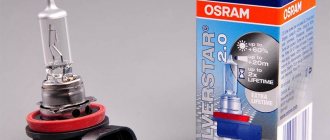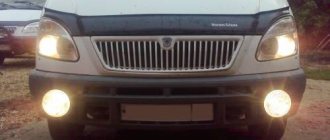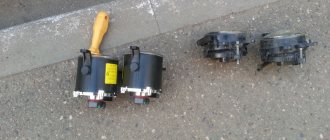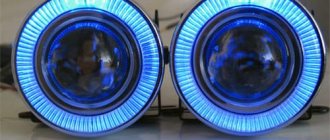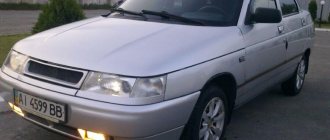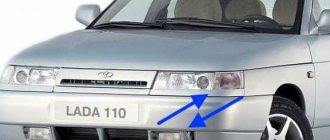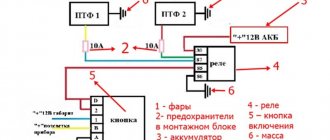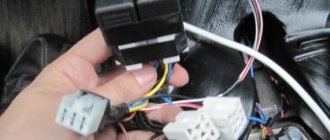The changes AvtoVAZ constantly makes to its conveyor models lead to the fact that, upon detailed examination, cars that are identical according to the documentation have significant differences. For example, not all factory VAZ 2110 have fog lights (PTF).
And the owners have questions about what needs to be done to connect them with their own hands? This article will discuss whether the connection of fog lights on a VAZ 2110 can “survive” without disassembling the front part of the car and the instrument panel.
In the photo - “ten” with foglights
Why are fog lights needed?
The very name “fog” lights already speaks about their essence. Their light penetrates fog, a wall of rain, and contributes to more efficient illumination of the road.
The presence of PTF provides three important advantages.
- PTF or fog lights are characterized by a flatter luminous flux, which literally spreads above the ground, spreading more in width than in height. This was done on purpose, since the temperature of the road surface is higher than the temperature of the air and fog, so it does not fall to the ground itself. Consequently, fog lights provide a certain range of illumination compared to conventional headlights. You will see approximately 10 meters further than with low beam.
- The width of the PTF light beam allows you to see the markings and the side of the road, which will allow you to make a maneuver in time and not end up outside the road surface. Unfortunately, this is a common occurrence in foggy conditions. Moreover, those who do not have fog lights suffer much more often. It is a fact.
- PTF does not blind oncoming cars, but allows them to see you. Only if the headlights are adjusted correctly, of course. Therefore, fog lights on your car have a big impact on safety by signaling oncoming cars that you are approaching.
Features of PTF (difference from headlights)
So, the main task of fog lights is to illuminate the road in poor visibility conditions (rain, snow, fog, etc.). However, unlike the head light, there are features.
First of all, PTFs must have the clearest possible upper cut-off line, and the beam of light must be strictly below and be as wide as possible. If these conditions are not met, this can become a problem both for the driver of the vehicle and for other road users driving in the oncoming lane.
We also note that even if the headlights have the most powerful lamp, the features, purpose and installation location of such headlights do not allow them to effectively illuminate the road in fog or rain.
The fact is that the head light should illuminate the road as far as possible, not blind oncoming drivers and cover the side of the road. However, in conditions of limited visibility, neither high nor low beam can cope with this task. The reason is that a powerful luminous flux is reflected from moisture particles, causing a cloudy “wall” to appear in front of the driver. This is especially noticeable when the high beams are turned on.
In turn, high-quality PTFs are characterized by lower power, and the optics themselves are made and installed so that the light from the fogs literally “breaks through” moisture and fog. The main secret is that usually the fog does not touch the ground, and the fog lights are as low as possible.
On the one hand, fog lights do not shine as brightly and far as the headlights, but in poor visibility conditions they illuminate several meters of the road in front of the car. The main thing is to follow the rules for installing PTF and setting up such optics.
In a nutshell, there are clear norms and standards that must be adhered to during installation. Additional adjustments allow you to set the fog lights so that the light flux falls on the road, does not blind the driver, does not form a “wall” in the fog in front of the car, etc.
At the same time, it is important to understand that cheap and low-quality PTFs, as well as incorrectly installed fog lights of a VAZ or any other car, will blind oncoming cars, but are not able to fully illuminate the road
For this reason, when selecting fogs, first of all, you need to pay special attention to this optics.
Instructions for installing and connecting fog lights on a VAZ 2110, 2111, 2112 with your own hands
For independent installation and connection, you will need plumbing skills, the ability to read and understand electrical diagrams, and a willingness to incur certain material costs.
Tools and materials
To install PTF you need to have on hand:
- multimeter (multitester);
- control light;
- a combination screwdriver with a slotted and cross-shaped working body;
- pliers;
- wire cutters;
- wrenches 8x10, 12x14;
- light hammer;
- electrical tape;
- packaging of heat-shrinkable tubes.
You can purchase a ready-made set of fog lights for the VAZ 2110 or buy everything separately (cheaper option):
- PTF - 2 pcs.;
- right and left frames made of plastic for VAZ 2110 fog lights - 2 pcs.;
- a key with a yellow backlit indicator;
- relay;
- wire with 2 copper cores of different colors with a diameter of 0.5 mm (for more powerful lamps, a diameter of 0.75 mm is preferable) - 5 m;
- narrow female connection terminals (single) - 8 pcs.;
- wide (double) female/male block for connection to each fog lamp - 2 pcs.;
- M8x45 bolts - 4 pcs.;
- “wings” for M8 bolts - 4 pcs.
Self-installation and connection
Before installing the PTF, you need to remove the plugs on the front bumper and secure the fog lights with frames. The best option: do not use self-tapping screws, but M8x45 bolts with wings, which provide more durable fastening and quick dismantling.
The fog lamp is inserted into a special frame, with which it is attached to the hole in the front bumper
Installing PTF will take a minimum of time if you follow this algorithm:
- Connecting to the electrical network should begin by pulling the wires from under the dashboard into the engine compartment. They must first be placed in a protective corrugation.
- The operation described above may require partial disassembly of the torpedo. On the VAZ 2112, the factory wiring provides this option for connecting the PTF, so you just need to find the connection pads, which are located near the socket plugs in the front bumper.
- Remove the positive terminal from the battery.
- Open the relay and fuse mounting block (located at the bottom left of the steering column near the clutch pedal).
- Unscrew the self-tapping screw with a screwdriver and remove the block.
The mounting block with fuses is located on the left side near the driver's left foot
After this, you need to find the terminals of fuses F4 (protects the right PTF) and F14 (protects the left fog lamp).
The location and purpose of fuses in the VAZ 2110, 2111, 2112 mounting block are indicated on the inside of the protective cover
Fuse F20 provides protection for the rear PTFs, which were originally built into the rear lights of the VAZ 2110 model range in the form of side light lamps with two filaments. In unfavorable weather conditions, the second thread is activated by a special button located on the dashboard.
At the final stage, you need to put copper connectors of the “female” type on the ends of the wires and insert them into the plug according to the attached electrical and wiring diagrams.
Electrical diagram for connecting fog lights VAZ 2110, 2111 and 2112 using a backlit key and relay
The choice of location for installing the fog lamp switch depends on the type of front panel. There are certain nuances in connecting the old PTF and the European panel.
Simple do-it-yourself connection of fog lights on a VAZ 2110 and VAZ 2111 with an old front panel without connecting the PTF switching relay
On VAZ 2112 models with a Europanel, wires for connecting fog lights are installed in the car wiring at the factory.
Wiring diagram for connecting the VAZ 2112 PTF wires to the factory wiring connected to the PTF sockets, mounting block, relay and to the backlit power button (connects independently)
General algorithm for connecting and connecting fog lights
Installation of fog lights will take approximately 1–1.5 hours if you proceed in the following sequence:
- The PTF wiring is laid on top of the main wiring, which runs along the left front fender.
- According to the factory's recommendation, power to the PTF power button, inserted into the socket on the dashboard, should be taken from the fuse for the right side lights. With this option, the PTFs will remain on when the ignition is turned off. If you don't turn them off with your button, the battery will quickly drain. But if the PTFs are powered from the main headlights button or directly from the ignition switch, they will light up when you turn the ignition key.
- Connect the plugs to the fog lights and turn them on. If the PTF on the VAZ 2110 and its modifications does not light up, it means that an error has crept into the wiring diagram. In this case, each element of the circuit should be checked again.
Self-installation
Electrical connection
Having purchased a ready-made PTF kit, you can begin to integrate it into the standard VAZ electrical wiring system:
- Disconnect the battery (remove “+”);
- Open the fuse box and use a screwdriver to unscrew 1 screw and remove the block into the passenger compartment;
The VAZ 2110 fog light switching circuit is protected by fuses
- We unfold the block and find the terminals of two fuses F4 and F14. The first is responsible for protecting the right headlight, the second – the left;
- The block also contains fuse F20, which is responsible for the operation of the rear PTFs;
Note! The connection diagram for the rear fog lights of the VAZ 2110 is initially present on all models, and consists of two-filament lamps in the side light unit.
- We insert the copper wire connectors from the kit according to the attached diagram;
- Separately, we bring out the wire for the button into the instrument panel and install it;
- We lay the wires through the partition into the engine compartment;
- Putting the fuse block back together.
Bumper installation
- Remove the plastic plug and insert the wiring with the connector into the hole;
- We connect it to the base and install the fog lamp for the VAZ 2110 in the bumper;
- Take a Phillips screwdriver and screw the headlight with 2 self-tapping screws;
- We pre-adjust its position;
- We secure the wiring in the engine compartment, leaving some slack for replacement (for example, a burnt-out lamp);
- We connect the battery and check the quality of the work performed.
The photo shows the process of fixing PTF in the front bumper
All that remains is to adjust the correct direction of the light flux. You will find information about this procedure in other articles on our website dedicated to AvtoVAZ models.
Question about glass color for fog lights
On old cars, the glass of the fog lights was yellow, so many people think that it should be like this now, it is more correct and more efficient.
In reality, everything is different. Today, auto industry leaders use exclusively clear glass for fog lights, which are superior to yellow ones in many components.
The current fog lights on the VAZ 2110 are available in two versions - transparent and corrugated. Most people choose transparent glass, although in fact, corrugated glass is better. They provide a clear directional beam that can show its best side during fog or rain.
Color meaning
Some people, in the old fashioned way, believe that it is better when the fog glass is yellow. But this is not true. Most leading manufacturers today produce transparent white fog lights, and they are not only as good as yellow ones, but often superior to them.
On the VAZ 2110 you can install corrugated or transparent glass. The latter are for some reason more fashionable, although less useful, since they shine in spots, while the corrugated ones give a more directed beam, which really increases visibility in bad weather.
Ready-made PTF kits
Today you can find 2 types of foglights on sale, in which the light spot is formed:
- Due to scratches on the glass (classic headlight with reflector);
- Due to the lens (so-called lensed).
Complete set of lensed headlights - wiring, relay and PTF with adjustment system and plugs
Tip: Making stickers for your headlights will protect your lenses from damage.
Which of them to choose depends not only on your desire, but also on the configuration of the set.
In particular, to install PTF you will need:
- Full compliance of the kit with your car model (in this case, VAZ 2110);
- The adjustment system is easy to use (meaning, without removing the bumper or partially disassembling the headlight itself);
- Visual instructions on how to connect fog lights on a VAZ 2110.
Each “correct” kit contains a wiring diagram for VAZ 2110 fog lights
Note! Only fog lights specially designed for the VAZ 2110 can be installed on a car without any body work. Manufacturers whose products are as easy to install as possible include the German Bosch and the domestic Avtosvet Plant, the price of whose products is significantly cheaper.
The famous “Kirzhachi” are produced at the Avtosvet Plant.
So, we found out that cars of the 2110 family may differ in the way they install PTF due to the technical features of the instrument panel and front bumper.
Everything else (installation of headlights and their integration into the electrical circuit) will not create problems, because:
- The automaker has prepared the vehicle as much as possible for the installation of PTF;
- Independent work will take only 1.5-2 hours of pure time.
Second option for connecting foglights
First, select an area to install the devices - for this purpose there is a small compartment below the bumper. By the way, headlights are different, some of them are corrugated, designed to diffuse light, and transparent ones illuminate with spots. Although transparent units are in great demand today among VAZ-2110 owners, experts consider them not so useful.
Installation begins by disconnecting the wires going to the fluid level sensor and washer reservoir. Disconnect the nut located on the washer tank and remove the entire bundle of cables located on the left under the side member.
When considering connector Ш1, you should take into account 3 wires: yellow and 2 yellow-black. Cut 2 pieces of yellow cable and stretch it inside the VAZ-2110 interior. Next, strip the cable, crimp it with male-type terminals of sufficient width and locate it inside the block so that the wire is connected to the one painted black and yellow.
Connect the block with 2 yellow wires together, press them to the harness, after which you can mount the washer tank in its original place.
Now you will need a wire (2 pieces) with a length of up to 0.5 m. Add the ground terminals and secure to the stud, also grab the ground wire coming from the headlight. When the cable from the fog lamp is already in the front side member, stretch the cable where you plan to fix the headlights. Don't forget to treat each cable with a ground terminal.
All that remains is to put the brackets on the bumper, and the female terminal blocks on the wires. Preparing headlights involves inserting light bulbs into the devices; experts do not recommend touching the light bulbs with your hands; when they heat up, the risk of heating increases and the devices may burst.
If you doubt that you have not touched the light bulbs, or you know for sure that you have touched them, you need to degrease the surface using alcohol. Next, connect the black cable to the housing base, and connect the yellow cable directly to the light bulb. Even a beginner, using this option for installing fog lights, will be able to figure out how to properly connect fog lights to a VAZ-2110, and will do it in just a couple of hours.
TOP manufacturers and models of PTF
Not all lights can fit into the 2110 bumper. To avoid mistakes, we have compiled the TOP models of fog lights from different manufacturers:
| PTF model | Manufacturer | Type of emitter and lens | Price |
| VAZ 2110 | Kirzhach Avtosvet | LED lamp, transparent, chrome base | 600 |
| Bosch VAZ | Bosch | Incandescent lamp, transparent, smooth | 900 |
| VAZ 2110 | Magneti Marelli Automotive light | Incandescent lamp, clear, corrugated | 950 |
| VAZ 2110 | LADA | Incandescent lamp, yellow, corrugated | 540 |
| LD 088 | DLAA | LED emitter, transparent | 1000 |
| PL 519 DLB | DLAA | LED emitter, transparent | 1300 |
fog lights VAZ 2110 installation outside
1) Remove the plugs in the bumper to install the headlights.
Remove the plugs in the bumper.
2) Install the fog lamp trim.
We insert the cladding.
3) We fasten the fastenings with two self-tapping screws.
We fasten the PTF fasteners with self-tapping screws.
4) It remains to connect the fog lights to the VAZ 2110 by connecting the connectors.
We connect the wires by connecting the “male” - “female” connectors.
- If the PTF is equipped with xenon, then you need a headlight range control to adjust the light output.
connection option 2
1) choose a place for installation - usually a small compartment located under the bumper. For VAZ2110 there are two types of PTF: corrugated (scattering light) and transparent (light comes in spots). Transparent ones are a more fashionable option, but the least useful.
2) you need to purchase a key with a yellow indicator, wires, relays, a ground terminal, narrow wide male terminals and corresponding female terminals, as well as blocks and frames for headlights.
3) Under the hood, disconnect the wires going to the fluid level sensor and washer reservoir. To do this, unscrew the washer reservoir nut and pull out the bundle of wires located under the left side member.
4) In connector Ш-1 we need three wires: two yellow-black and one yellow.
5) Then we cut off two pieces from the yellow wire and stretch them inside the car. We strip the wires, attach wide male-type terminals to them, then insert them into the block so that the marked wire connects to the yellow-black one. We connect the block and press the two yellow wires to the harness, put the washer reservoir in place.
6) Next, take two more pieces of wire, each 50cm long. We attach a ground terminal to them and screw it to the stud along with the ground wire from the headlights.
7) stretch the fog lamp wire from the front side member, pull out both wires where the headlight itself will be attached. We attach a wide ground terminal to each wire.
 Next, we put the brackets on the bumper, and the wide female terminal blocks on the wires
Next, we put the brackets on the bumper, and the wide female terminal blocks on the wires
9) Insert the light bulbs into the headlights.
Tip: insert the light bulbs into the headlights without touching the light bulbs with your fingers. Otherwise, after heating, the bulbs will burst. If you happen to touch the light bulbs, degrease their surface.
10) Connect the yellow wire to the light bulb and the black wire to the body.
- The entire PTF installation procedure takes about two hours.
connection option 3
2) Take the PTF block, and stretch the red wire to the black box (BY), connect it to the relay block No. 85.
This is the same wire.
3) Contact No. 3 in block Ш-1 is powered from terminal No. 30 located on the relay block.
Block Sh-1.
4) Contact No. 5 from block Ш-1 is connected to terminal No. 87 in the relay block.
Contact number five.
5) Using a connector, we connect the black wires on the relay block No. 86 and on contact No. 4 from the Sh-2 block.
Connector.
6) Then we connect the yellow wire to contact No. 1 of the Ш-1 block, and lead it to the left headlight.
We connect the Ш-1 block to contact No. 1.
7) We connect the right headlight to contact No. 6 of the Ш-1 block using a yellow-black wire.
Connect the right headlight.
 We insert the Ш-1 block into the connector.
We insert the Ш-1 block into the connector.
Connected block Ш-1.
9) Place the relay block on the back wall of the black box.
Black box.
10) Go to the dashboard. We connect the green wire from the PTF block, located on contact No. 10, to contact No. 58R (in the photo it is on top).
Above we see the same wire.
11) Connect the two white wires. One from the PTF block, and the other from the light switch using a connector. Black wire with black respectively. We return the instrument connections, buttons and visor to their places.
We connect the white and black wires with connectors.
12) Return the button with the PTF wires back to the dashboard housing.
We return the wires and the button to the housing.
13) The remaining two wires: black coming from contact No. 7 and pink coming from contact No. 9 are connected to the fog light indicator through the block.
We connect the wires through the block.
14) Insert the button into the panel.
Attention: Be sure to check whether the button backlight and the PTF on indicator are working.
We check the operation of the backlight.
Let's check the indicator's operation.
The connection of the fog lights is completed; we also recommend watching the training video.
We install xenon in the foglights of a VAZ 2110 with our own hands
- First, we install the H1 bulbs in the cap of a plastic bottle. Then, using sealant, into the headlight.
A light bulb installed in a bottle cap.
- There are often cars with xenon installed in the main headlights. If the beam of light has even boundaries, it is even possible to legalize xenon when preparing documents for a car.
We install the light bulb using sealant into the headlight.
- When there are no lenses in the headlights (there is only a reflector), your car exhibits glare beyond the permissible limits and leads to dazzling of other road users.
Xenon fog lights with lenses.
- All the benefits of xenon light come with a focusing lens that ensures the correct distribution of the light beam. PTF with xenon light - they do not dazzle if they have a focusing lens, and make the fog function better.
The third diagram for connecting headlights
It consists of 3 images, where you can see the connection features of the VAZ-2110 fog lights, the relay block, connectors Ш1 and Ш2, which makes up the PTF.
- Taking the headlight block, run the pink wire directly to the black box, where it needs to be added to the relay block numbered 85 (see picture).
- Provide power to contact number 3 of the block, designated Ш1, from terminal No. 30, located on the relay block.
- During installation of lighting devices, terminal 87 must be connected to contact 5 from block Ш1.
- Armed with a connector, connect to each other the black cable located on relay block No. 86 and on contact No. 4, taken from block Ш2.
- Check if the key backlight is working.
- The fog light on indicator implies exactly the same check.
Requirements for installing PTF
How legal is it to independently install fog lights and will it not cause problems when meeting with traffic police officers? Let's consider excerpts from the standards by which PTF is established by the manufacturer (GOST 8769–75 and GOST 41.48–2004):
- Number of lanterns – 2 pcs.
- Installation height – not lower than 25 cm from the road surface, but lower than the low beam lights.
- Installation in width - no further than 40 cm from the side lights.
- The vertical coverage angle is 5-10 degrees.
- The lighting angle of the road surface (horizontal) is 45-55 degrees.
- PTFs are turned on only together with the side lights.
Types of instrument panels and location of fog lamp buttons
As I noted above, depending on the modification, VAZ 2110 cars are equipped with two types of panels: the so-called old panel and the European panel. If you have a Europanel installed, then the place to install the button for turning on the fog lights is located to the left of the steering wheel, and this button is located in close proximity to the button for turning on the side lights.
Selection of fog lights for the VAZ 2110
The range of PTFs for the VAZ 2110 today is quite wide: large and small, round and square, yellow and white. Which ones to choose? Everything here will depend on your taste and financial capabilities, but I still dare to give some advice.
- Yellow light is less absorbed by water (and fog and rain are water). This means that yellow PTFs will produce a higher quality light spot than white ones of the same power, and at the same time they will not dazzle oncoming drivers.
- The shape of the headlights does not matter, the main thing is that they should fit the seats of your bumper as best as possible.
- You should not buy very expensive headlights from famous brands. Most often, such companies charge a lot of money just for the fact that they are famous (the so-called surcharge for the brand).
- Before purchasing, take the headlight in your hands and carefully examine the quality of the body and glass. Even by its weight and appearance, you can feel whether it is a worthwhile thing or junk that will fall apart after 100 km of run.
Below I will give some common and affordable PTF models for the VAZ 2110 that really deserve attention.
Legal requirements
In auto parts stores you will find a huge selection of fog lights of different shapes and sizes.
But everything depends on the existing GOST 8769-75, according to the requirements of which:
- Fog lights are only allowed to be installed in pairs;
- Each headlight must be at least 400 mm away from the plane of the side marker (measured along the outer edge of the lens);
- The distance from the road to the lower edge of the lens should not be less than 250 mm;
- PTFs should not be installed higher than the head light.
Despite the “menacing appearance”, the connection diagram for fog lights on the VAZ 2110 has been followed
Note! It is allowed to install PTF on the roof of only those cars that are used on rally tracks or in Off-Road competitions.
Unexpected reasons for non-working PTFs on the VAZ-2110
The most common cause is a blown fuse. But we will return to it later. There is still a lot that is still unknown in the design of foglights, relays, switches and lamps. For example, a possible reason for the failure of fog lights could be a completely unexpected breakdown.
First of all, we check the bulbs themselves; you can get to the left one through the hood. On some versions of the VAZ-2110, a PTF from the Avtosvet plant (Kirzhach) was installed with a socket for the H1 lamp. Stock lamps are not the best quality and they do not like sudden changes in temperature.
It is quite difficult to get to the right fog lamp through the hood; it is easier to remove the headlight itself by unscrewing the screws.
During sudden cooling, when leaving the garage in winter, for example, or after turning off the headlights, the contact leg of the lamp bulb simply fell off the conductor. At the same time, visually the halogen lamp looked absolutely intact. It was enough to apply a plus directly to the leg itself, and the lamp would light up. The fault was due to poor-quality resistance welding, and it is almost impossible to detect the cause without a detailed examination of the lamp itself and its dismantling.
Of course, it is impossible to provide for all failure options, but we will consider the most common ones.
Which ones are better?
Typically, standard optics have halogen elements; replacing them with the same ones, but more powerful, makes no sense. It is better to install LED lamps in fog lights; a good option is to replace the fog lamp with xenon (author of the video - Learning to drive a car. All the secrets for beginners.).
LEDs can be installed in PTF without restrictions, unlike xenon. Replacing a light bulb in a fog lamp does not require special equipment or specific knowledge, so you can replace it yourself. It is better to buy products from trusted brands, since cheap Chinese samples are often of poor quality and quickly fail.
When purchasing LEDs, you need to select a lamp with a base similar to the halogen counterpart. An important parameter for fog lights is brightness, measured in Lumens (Lm). Anti-fog lights must have a brightness of at least 1000 lm.
Correct installation and connection of fog lights VAZ 2110 and its modifications
Not all models of the tenth row of VAZ are equipped with factory fog lights. If the driver independently tunes additional lighting, he has three options for solving this problem:
- Buy a front bumper with fog lights already installed. They just need to be connected to the car network.
- Buy a front bumper with ready-made stamped sockets for installing PTF. In this case, you need to choose the right set of fog lights and install them yourself.
- Make holes in the plastic for the PTF yourself, attach the fog lights and connect them to the car’s network. This option allows an experienced driver to install fog lights from foreign cars on the VAZ 2110 model range.
The “tens” model range is equipped with PTFs with corrugated (provide a narrowly directed light flux) or transparent (gives spots of light) glass.
The requirements of the Road Traffic Regulations do not contain a mandatory condition for installing PTF on cars, so domestic manufacturers do not always install fog lights on the assembly line. But there are GOST 8769–75 and GOST 41.48–2004, which regulate the number, location and order of switching on all lighting devices, including fog lights.
Requirements for installation of PTF
Fog lights are installed according to certain rules:
- quantity - 2 pieces;
- no closer than 25 cm to the surface of the road surface;
- no more than 40 cm from the outer contour of the headlights;
- sockets for fog lights should be located below the top point of the low beam headlight socket;
- The line of sight angles of the PTF should be: in the vertical plane 5° +5°, in the horizontal plane - 45° +10°.
The location of two PTFs in the front lower part of the car must meet the requirements of GOST 41.48–2004 (clause 6.3)
The fog lights turn on only at the same time as the side lights.
Modern brands of vehicles, as a rule, are equipped with PTFs, which are installed by the manufacturers themselves. For this purpose, special sockets are provided on the front bumper. If the fog lights are not installed there, the holes are closed with plugs that can be easily removed.
If the installation of PTF is not provided for by the car, the factory stamped holes for installing fog lights are closed with plugs on two screws
The first editions of the VAZ 2110, 2111 and 2112 were not equipped with holes for installing fog lights, so the sockets must be marked and cut out with your own hands, taking into account the above requirements.
Preparing for installation
Self-connection of PTF on VAZ 2110, 2111 and 2112 involves minimal disassembly of the front part of the car (preferably without removing the front bumper) and the front panel (dashboard). Therefore, before buying a ready-made set of fog lights, you should find out:
- what kind of dashboard is on your car;
- Are there any stamped holes for them in the front bumper, what is their shape, as well as the method of attaching the PTF.
You need to act carefully so as not to create unnecessary difficulties for yourself. If there are no sockets for fog lights in the plastic bumper, then they can be easily made using a drill, a heated metal plate, or cut out with a hand jigsaw. The main thing is to correctly mark the size of the finished PTF kit with fasteners, take into account the curvilinearity of the bumper, the structure of the material (fragile, soft, hard).
You can make your own nest in the bumper using a drill and a thin drill with a diameter of 2–3 mm, often placing the holes along the contour
You need to remember a simple rule. If there are stamped sockets for fog lights, then we select the shape and size of the headlights to match them. If there are no holes, then first we buy PTF, and then mark according to their shape and make places for attaching fog lights
Choosing a headlight manufacturer
Drivers, first of all, always need a good low beam. Kirzhach headlights are equipped with a lens for low beam and, accordingly, a reflector for high beam. Bosch uses reflectors in both cases. Unlike a reflector, the lens has a much clearer light line; in addition, Kirzhach lighting devices can be legally “equipped” with xenon, which is not provided for Bosch. However, if we compare the results of the review of experts and the opinions of car owners, it is worth noting that they are somewhat different. Bosch headlights have weak flare from the side in the low beam, but besides this, they are the ones that cause preference. In addition, they have a large surface for low beam due to the reflector. This has the best effect on the quality of automobile road lighting in cloudy weather.
In order for lighting to be as productive as possible at night, choosing high-quality optics is not enough. The headlights should be adjusted correctly, and the glass should be clean (the glass should be secured with a sealant, but on Bosch they are held on by sealants. This makes the process of replacing glass easier). However, the best option would be to use bright halogen lamps for car lighting.
Materials and tools
You can easily buy a ready-made PTF kit with all the wires, and then you won’t have to figure out where the fog light relay is located on a VAZ 2110. However, if you purchase spare parts separately, this will diversify the installation options, plus it will allow you to save money.
Connection kit
Therefore, you need to purchase the following:
- Two sets of headlights;
- Plastic pads;
- Headlight frames;
- A key with a yellow indicator for it;
- Relay;
- Wiring. Choose an option with two copper conductors and double insulation, for example ShVVP2. A cross section of 0.5 mm is suitable, but if the lamps are powerful, 0.75 mm is better;
- Ground terminals;
- Female/male terminals - wide and narrow terminals.
It is not worth taking the mother-father complete with wires. It is better to crimp them using pliers when the wiring is already connected.
Pay attention to what kind of dashboard you have. If it is an old model, buy a set of fog lights for the VAZ 2110, and if it is a Euro dashboard, then it is better to use the PTF for the VAZ 2115.
As for the light bulb, 55V is more than enough power. We strongly do not recommend buying cheap fog lights, since their service life is very short.
Installation
A diagram for connecting fog lights on a VAZ 2110 is always offered with the purchased kit, so there shouldn’t be any special problems. But keep in mind that something may need to be corrected or adjusted to ensure effective operation.
Connection diagram
Before installing fog lights on a VAZ 2110, you need to decide on their location. If the design of the car does not provide space for them, then they will be mounted under the front bumper.
The PTF connection diagram is as follows.
- We install the wiring for fog lights on your car. This is done through the left side under the hood along the fender. The main wiring is approximately the same.
- Now you need to connect power to the button, which is located on the dashboard. According to the factory diagram, power is installed from the fuse on the right dimensions. But you can use the light switch button or the lead from the ignition switch to turn on the head optics. That is, in such a situation, the fog lights will turn on when the ignition is on. Some take power from the output to the dimensions. This can be done, but is not recommended. If you forget to turn off the PTF, the battery will soon run out.
- We connect the plugs to the headlights. If after this the fog lights on the VAZ 2110 do not light up, an error was made in the circuit. Check every element of the circuit. It is not difficult to determine where the fog lamp relay is located on a VAZ 2110, so make sure that the relay clicks. If it is present, then the coil will activate it. It is not uncommon to have to change a relay.
The last stage of installation begins after all the wires have been connected, the power has been turned on, and the light from the fog lights has spilled out. It's about adjustment.
Checking whether the PTF lights are shining correctly is quite simple. Get out on the road and see how the fog lights work. If the light is directed slightly downwards, the luminous flux touches both the road surface and the side of the road, then everything is working perfectly, and you don’t have to worry about the wrath of oncoming drivers whom you will blind.
If there are deviations from the norm, be sure to make adjustments. This work can be done independently, but ideal room conditions will be required. Therefore, it is better to trust the specialists from the car service center, who have a special stand, a flat area, and equipment for adjustment.
Selection options
How to choose the best universal fog lights:
First, decide on the cost you can afford. You must understand that the lower the price of the optics, the more likely it is that it will not work correctly. More expensive options usually have an increased service life and function much more efficiently. Also decide on the manufacturer. As practice shows, currently the highest quality goods are produced not by Chinese, but by European manufacturers. For example, brands such as Osram or Philips have long shown their superiority and won the trust of domestic consumers. Evaluate the quality of optical protection, that is, protective glass
It is important that the headlight is equipped with glass rather than plastic, since the latter has a short service life and is more susceptible to damage. For example, a crack in the plastic may appear as a result of an accidental hit of a pebble from under the wheels of another car on the headlight.
You cannot drive with a cracked or damaged headlight plastic, since in bad weather this can lead to moisture getting into the headlight itself. Therefore, the plastic will have to be changed in any case. Also pay attention to the fog light housing. It is desirable that it be metal and not plastic, since again, we are talking about the service life of the devices and their possible damage. The material from which the case is made must be as resistant to mechanical as well as temperature influences. If you still prefer cheaper Chinese analogues, then make sure that all wire connections are reliable and the wiring itself is thicker. If thinner wires are used, they can quickly fail due to overvoltage.
Fog lights should be purchased taking into account the mounting locations provided for their installation in the bumper. As mentioned above, PTFs can be oval, round, rectangular or square in shape. So, the shape of the headlights should be chosen taking into account the places provided for their installation. You also need to understand what color of glow you want to see. If the headlights are yellow, then it may make sense to install headlights with halogen bulbs so as not to disturb the exterior of the car. If the color of the lighting is white or blue, then it makes sense to think about installing LED or xenon PTFs. It is desirable that the body shape be aerodynamic, this will make it possible to avoid possible noise when using the flashlights. If you purchase lensed flashlights for gas-discharge lighting sources, then you need to devote time and attention to their adjustment. Otherwise, there is a chance that you will blind drivers of other cars. Sooner or later you will need to change the light sources in your headlights. Therefore, when purchasing, choose optics that will allow you to replace failed light bulbs with minimal physical and time costs. It is important that the optics have reliable fastenings and allow adjustment of the lighting flux. And not only vertically, but also horizontally. It is better that the design of the purchased products succinctly fits into the exterior of the vehicle. Fog lights should not stand out. If you buy PTF with light bulbs, then remember that their too high power can negatively affect the operation of the generator device, as well as electrical circuits. It is better to give preference to light bulbs with a power of no more than 55 W (video published by the user Avtolyubitel).
Types of instrument panels and location of fog lamp buttons
As I noted above, depending on the modification, VAZ 2110 cars are equipped with two types of panels: the so-called old panel and the European panel. If you have a Europanel installed, then the place to install the button for turning on the fog lights is located to the left of the steering wheel, and this button is located in close proximity to the button for turning on the side lights.
On some modifications of the Europanel, the buttons for sidelights and fog lights may be located one above the other:
On a regular, old panel there is no special place for installing a PTF switch, but there are places for installing additional buttons for any purpose, including for connecting PTF. They are closed with plugs and are located on the switch panel between the driver and passenger.
On cars with an older panel, the space for additional buttons is located to the right of the driver
The indicated installation locations for the fog light switch on a VAZ are recommended, but not required. You can install the PTF button in any place convenient for you.
How does the device in question work?
The main features of this relay can be considered the following:
- The type of device is normal open, the type of block is six-pin; to ensure convenience and simplify the connection, the numbering of the contacts is present on the body of the product.
- The system is assembled in such a way that the contacts close by trigger. In simple terms, the design functions like this: when you press the button, the system turns on, when you press it again, it turns off.
- The most important feature of the device is that it functions only when there is voltage on two additional contacts. It is thanks to them that the button automatically turns off when the car’s ignition is turned off.
- The relay can be designed to operate in systems with a current not exceeding 20A .
This is what the circuit of the relay we are considering looks like
Important! As noted above, the unit began to be installed in cars since 2000, so you should not believe experts who claim that the relay was not installed on this model. They just haven’t encountered this version of the system, and since products fail quite rarely, such a question does not arise so often.
How to assemble an electrical circuit
Let's start with the fact that according to GOST, fog lights must turn on simultaneously with the side lights. But this does not mean at all that the latter cannot be turned on without PTF. That is, when the side lights are turned off, the fog lights will not light up.
scheme
diagram First, we install the relay. The location for this can be chosen anywhere, for example, behind the dashboard. We connect the wire from pin 86 to the nearest negative wire, suitable for all devices on the panel, or we place it on the body. After this, we will stretch the wire that will be connected to 85 to the installation location of the PTF disable and enable button and make a connection to its contacts. From the second contact of this switch the wire goes to the +12 V contact on the ignition switch.
The wire from relay contact 87 is pulled through the plug to the fuse contact, while its second contact is connected to the positive terminal of the battery. It is best to place the fuse as close to the battery as possible. The wires going to the terminal of the anti-decoys connected in a parallel circuit are connected to the 30th contact of the relay. The second terminal of the PTF is connected to ground or the negative wire of the main headlights located nearby.
After this, all elements of the assembled circuit are carefully checked to ensure the quality of the connections made and the absence of even the theoretical possibility of a short circuit. After this, you should check the functionality of the circuit by connecting headlights that have not yet been installed to it. Only after this can you proceed to the next stage - connecting the fog lights.
Basic Rules
To ensure good visibility in thick fog, it is important to follow these rules:
- Adjust the edge of the light beam so that the light beam is above the horizontal plane.
- Place the flashlight as close to the road as possible. This is necessary to make it easier to adjust the edge of the light beam.
Correctly adjusted headlights guarantee excellent visibility on the road, even in difficult road conditions. To prevent deterioration in the quality of the glow, it is important to monitor the condition of the ceiling. If necessary, polish the surface and remove scratches, as they impair light transmission.
